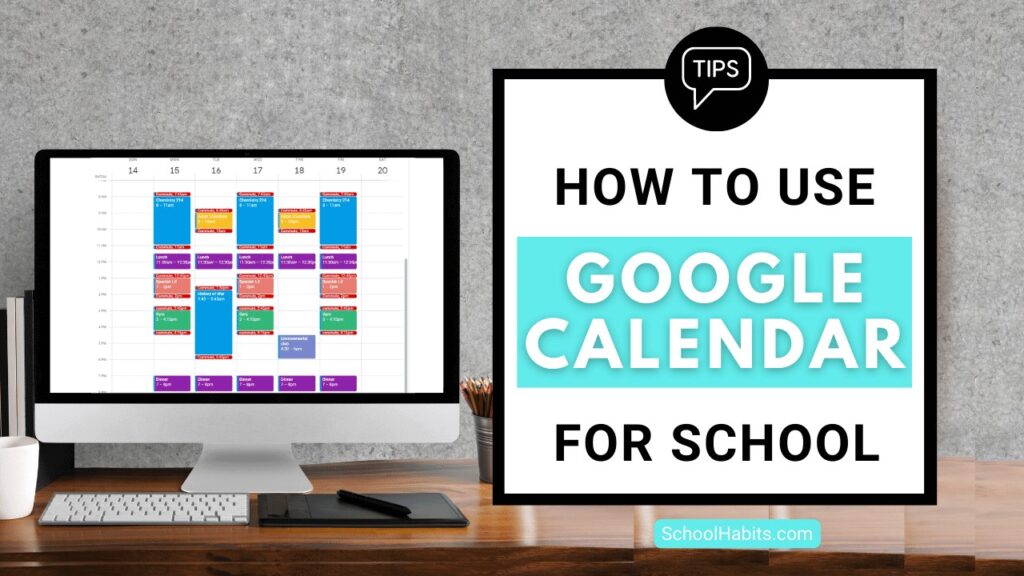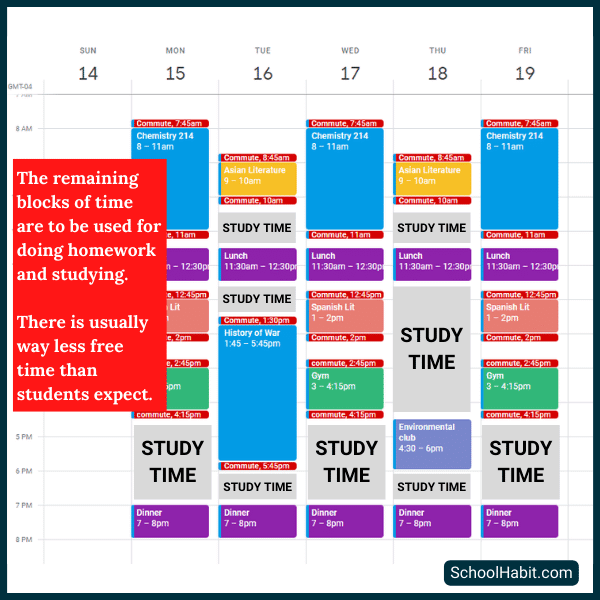
By Katie Azevedo, M.Ed.
Knowing how to use Google Calendar for school is important for high school and college students. Using Google Calendar to create a calendar:
- help you manage your time
- keep you organized
- help you show up when you need it
- provide reality checks on how much time your engagements are actually consuming
I recommend that students use Google Calendar over any other digital calendar app. Why? Google Calendar easily integrates with other Google products for schools. Plus, the desktop and mobile apps are excellent.
What you need before you start with Google Calendar
You only need two things to start using Google Calendar to plan your school schedule.
- A google account
- Dates and times to put in the calendar
Let’s start with #1: Create a Google Account if you don’t have one. If you have multiple Google accounts, sign in to the one you use for school.
Let’s move on to #2: Gather all the information you’ll need to load into Google Calendar. This would include:
- Your lesson schedule
- Your school calendar for the school year (usually on your school’s website)
- Sports schedules
- Work schedule (if you have a part-time job during school)
- Dates and times of recurring appointments (therapy, physiotherapy, music lessons, etc.)
How to create your school timetable in Google Calendar
1. Add classes first
The first step to creating your school timetable in Google Calendar is to add your classes. If you’re in high school, you can just block out some of the time between the first bell and the last bell (picture #1). If you are in college, you will need to add each individual class.

To add courses that repeat on certain days, simply click on Don’t repeat for a list of repeat options. Or, you can click Custom to select specific days. See pictures below.


2. Add drive times
After adding classes, add the travel time to and from each class. Do the math to calculate how long it takes to drive or walk to class. Be precise. See image below.

3. Add meals
Add your meals to your Google calendar calendar. If you don’t usually eat breakfast, don’t add it. But if you take something to take to the dining room, even if it only takes you 10 minutes, add it.
Enter the lunch and dinner blocks at your “average” times.

4. Add recurring engagements
Enter all recurring commitments and appointments. Remember to add travel time to each event. Consider the following:
- Classes
- therapy
- Gym
- practices + games
- doctor + dentist appointment
- club meetings

5. Create dedicated study blocks
Once you’ve added all “still” engagements to your calendar, you can see the open time gaps in your schedule. There will probably be a lot less free time than expected. Here’s your reality check.
The majority of these unscheduled hours will become your study blocks. You should have at least one large or several smaller study blocks per day. If you don’t, your school schedule is overloaded and you need to change something.
Block out those study/homework periods events on your calendar, just like you did for classes and other commitments.

8 After pro tips for using Google Calendar to create your school timetable
1. Only create your schedule for one semester at a time. You can create endpoints for events in the Edit section of each event by filling in the ends on field with the last day of your semester. See picture.

2. Use specific colors for each event category. For example, use blue for all courses and green for all meals. As of this writing, you’re limited to Google’s 11 basic color options, but this tutorial shows you a workaround if you intend to create custom colors.
3. Create your initial school calendar on a desktop computer. There are more options and features in the browser version than in the app. Plus, it’s easier to add and customize events on the desktop.
4. Download and use the Google Calendar mobile app. If you need to add an event on the go, add it through the app, then customize it from your desktop as needed.
5. Do not add assignments to the schedule. A calendar is not a homework book. Simply add due dates and exams as described in step 6 below. Here is the important difference between a calendar and a homework book.
6. Add due dates and tests to your calendar. To do this, you would add it as one day event. This will make the event appear at the top of the day, rather than at a particular time. See picture.

7. Create an SRoutine of the day like this one where you log into your calendar and make updates for the week. Make this planning routine non-negotiable. Consider doing the following once a week:
- add new appointments and events
- delete events or classes that have been canceled
- adjust gym schedule or meal times as needed
- add due dates and tests for the coming week
8. Add event and appointment details by clicking Edit and filling in the description field. This is a good place to store teacher information like office hours and absenteeism/catch-up policies. See picture.

Using Google Calendar for school is one of the best productivity tools available for students. Using it to create a visual calendar of your commitments is a very effective way to see, manage, organize and control your time.

